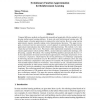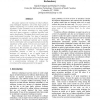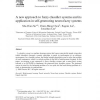53 search results - page 6 / 11 » Testing Probabilistic Equivalence Through Reinforcement Lear... |
JFR
2006
13 years 7 months ago
2006
In mobile robotics, there are often features that, while potentially powerful for improving navigation, prove difficult to profit from as they generalize poorly to novel situations...
CORR
2010
Springer
13 years 7 months ago
2010
Springer
Temporal difference methods are theoretically grounded and empirically effective methods for addressing reinforcement learning problems. In most real-world reinforcement learning ...
IAT
2005
IEEE
14 years 1 months ago
2005
IEEE
This paper explains the building of robust software using multiagent reputation. One of the major goals of software engineering is to achieve robust software. Our hypothesis is th...
IJON
2006
13 years 7 months ago
2006
A classifier system is a machine learning system that learns syntactically simple string rules (called classifiers) through a genetic algorithm to guide its performance in an arbi...
SDM
2008
SIAM
13 years 9 months ago
2008
SIAM
In this paper we present the Dynamic Grow-Shrink Inference-based Markov network learning algorithm (abbreviated DGSIMN), which improves on GSIMN, the state-ofthe-art algorithm for...



